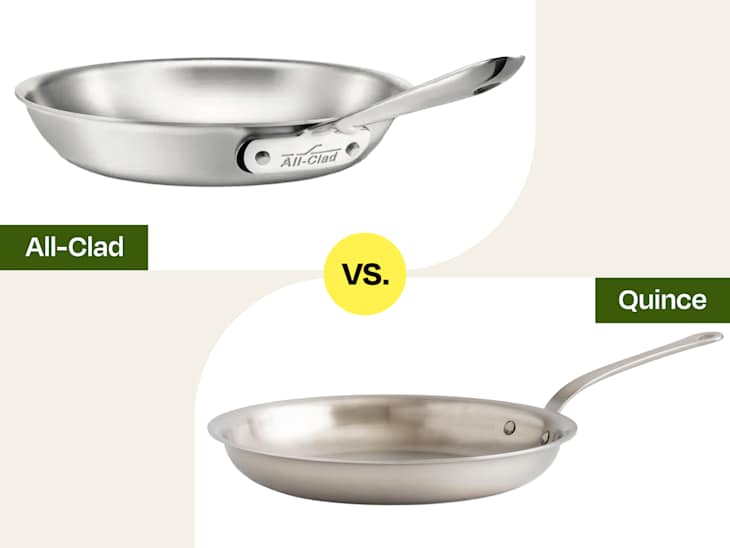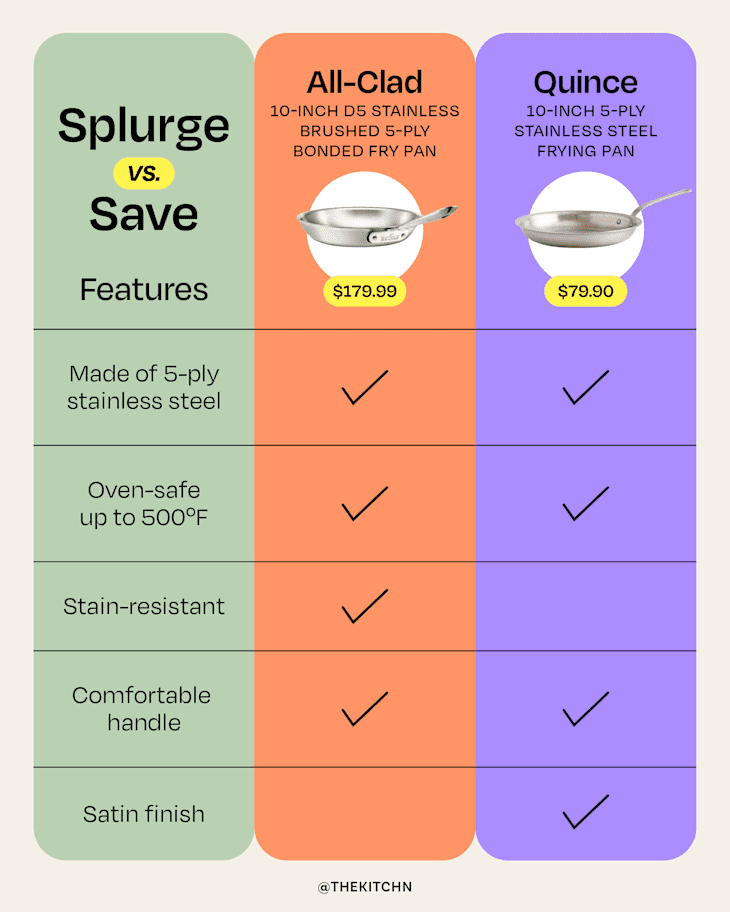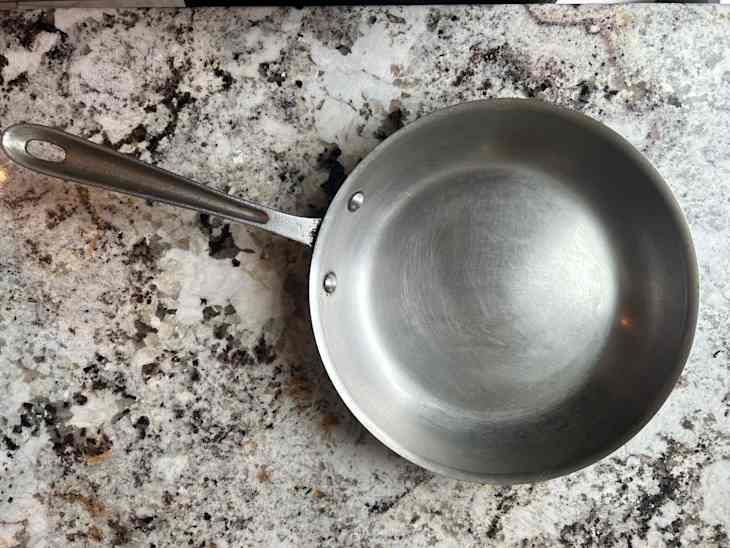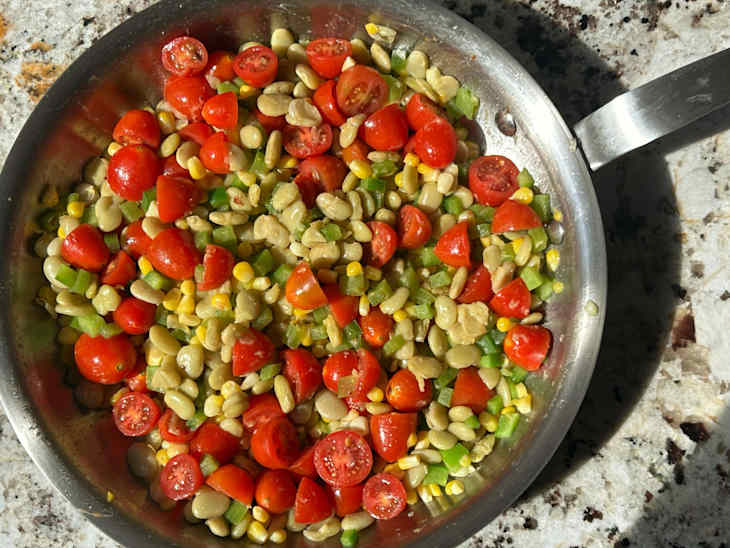

When it comes to must-have kitchen equipment, you’d be hard-pressed to find a chef who wouldn’t recommend owning a good stainless steel skillet. They’re relatively inexpensive, endlessly versatile, and can last you years, if not decades, when properly taken care of. For this reason, there are thousands of options on the market today, with prices ranging anywhere from tens all the way up to hundreds of dollars. So how do you know which skillet is worth making your “forever”pan? Enter: Splurge or Save, our series that compares two editor-tested (and loved!) products that serve the same purpose, but at different price points.
For this round, we tested two 5-ply, 10-inch stainless steel skillets: All-Clad’s D5 Brushed Stainless Steel 10-inch Fry Pan, which retails for $179.99, and Quince’s 5-Ply Stainless Steel Frying Pan, which retails for $79.99. One brand has a cult-like following and has been crafting American-made, specialty cookware since 1971. The other is a relatively new, direct-to-consumer brand specializing in affordable, sustainable luxury goods. So which skillet came out on top? Here, we break down everything you need to know to decide which skillet is right for you.

The Verdict
Both the All-Clad and Quince skillets would be fantastic additions to anyone’s cookware assortment — however, if you have the extra $100 to spend, we say go with the All-Clad. While both skillets will absolutely get you where you need to go, the extra 1/2” of base space and steeper sides make the All-Clad pan a smidge easier to cook with. That being said, the Quince pan is still a fantastic-performing pan at an extremely enticing price.
All-Clad vs. Quince
In some ways, the comparison of All-Clad vs. Quince might feel like a bit of a David and Goliath story. On the one hand you have All-Clad, a trusted mainstay in the cookware space with over 50 years of experience stocking professional and home kitchens alike. With a focus on utilizing American-made steel from their own factory in Canonsburg, Pennsylvania, All-Clad’s bread and butter is crafting fully bonded steel cookware meant to last a lifetime. Over the years, the brand has expanded its footprint, growing its assortment to include necessary kitchen essentials of all kinds, including knives, bakeware, and kitchen appliances. While All-Clad is definitely on the pricier side, it’s hard to argue that the brand’s expertise in metalwork doesn’t warrant the extra bucks (in fact, All-Clad’s founder and renowned metallurgist John Ulam held more than 75+ patents in metal crafting).
On the other hand, you have Quince, a newer-to-market brand focused on bringing consumers high-end, luxury goods at eyebrow-raisingly low prices. With a vision for “sustainability, accountability, transparency, and amazing value” in everything they make, Quince’s ethos involves disrupting the traditional supply chain to cut down on costs without cutting back on quality. They do this by removing the middle man, avoiding the use of unnecessary packaging, and shipping directly to the consumer from their global network of partner factories. Quince positions itself as your one-stop-shop for high-quality home goods at affordable prices. Oh, and they only use 100% compostable packaging and recyclable mailers too.
All-Clad’s 10-Inch Stainless Steel Skillet
Specifications
- Weight: 6 pounds
- Material: Stainless steel with brushed exterior
- Oven safe: Yes, up to 600°F
- Handle length: 13 3/4 inches
- Depth: 3 inches
Throughout most of my cooking career — both professionally and at home — I’ve leaned heavily on All-Clad products. With its longevity on the marketplace, chances are that if you need a specific piece or size of cookware, there’s an All-Clad version that is up for the task. Of all the products in my arsenal of All-Clad, the 10-inch stainless steel skillet has truly become my Swiss army knife in the kitchen. Whenever I need to toss some sautéed vegetables or get a hard sear on a piece of meat (because, let’s be honest, sometimes you don’t want to lug out your cast iron skillet), I reach for this pan. It excels at what you’d want out of a stainless steel skillet — searing, roasting, sautéing, etc. — but it really shines when you look at the details in its construction.

First, we have the handle. With a longer-than-usual length, I find that the end of the handle stays cooler for longer when the pan is set over heat. Additionally, the handle points upwards rather than straight out. This creates an ideal angle for both controlling the pan while sautéing, as well as directing it away from the flame to maintain a cooler temperature. Second, the sides of the skillet are angled just right to help contain the heat inside the pan; they also stop food from flying out of the pan when doing some serious stirring. While there are definitely more affordable options available, it’s hard to argue against the All-Clad’s value for the dollar — especially as my assortment has held up beautifully over the 10 or so years since being in my kitchen.
Quince’s 5-Ply 10-Inch Stainless Steel Frying Pan
Specifications
- Weight: 3 1/2 pounds
- Material: Stainless steel with satin-finished exterior
- Oven safe: Yes, up to 500°F
- Handle length: 8 1/4 inches
- Depth: 2 3/4 inches
While my relationship with Quince is certainly not as tenured as that with All-Clad, cooking with their 10-inch skillet for a week felt like cooking with an old friend. The skillet is similarly beautiful in its construction, designed with 5 layers of alternating aluminum and 18/10 steel for even heat distribution (food-grade stainless steel is often found in either 18/8 or 18/10 grades, which refers to the ratio of chromium to nickel in the formulation of the steel). The riveted handle is long and comfortable in the palm, and allows for a bit more leverage when holding the skillet — which is slightly larger and heavier than the All-Clad pan. Just as Quince suggests, this pan truly became my workhorse for the week.
On our first night together, I seared some salmon. The pan heated quickly and evenly, allowing for a uniform crisp on the skin with minimal sticking. Similarly, when cooking the most basic pan-roasted chicken breast the next night, the chicken got a beautiful sear and easily transferred in and out of the oven, with the handle staying relatively cool to the touch. That being said, I wouldn’t recommend attempting any stovetop-to-oven maneuvering with anything too heavy in the pan, as the skillet’s slightly larger diameter and lack of opposite side handle places most of the weight on your wrists.

When tasked with sautéeing a summertime succotash for dinner mid-week, the skillet did everything I needed it to do. The angled channel of the base allowed for my wooden spoon to sweep through it easily, which ensured that no bits of vegetables were being disregarded in the corners of the pan.
The only real shortcoming of the pan came in the cleaning of it — and really, it was more of a slight annoyance than a true flaw. After washing with soap and water and towel-drying, the base of the pan started to develop small white marks along its surface, seemingly from the mineral deposits in the hard water of my Brooklyn apartment. My All-Clad pots and pans have never shown these marks (after all, stainless steel is loved for being just that, stainless), so it led me to believe the reaction might have been due to the satin finish on the pan. Nonetheless, some Bar Keepers Friend and a touch of elbow grease took those stains off with ease. Overall, the Quince stainless steel frying pan is a well-priced, jack-of-all-trades skillet that would make a great addition to any home kitchen — just maybe keep some good cookware polish on hand to keep it shining sparkly and new for the years to come.